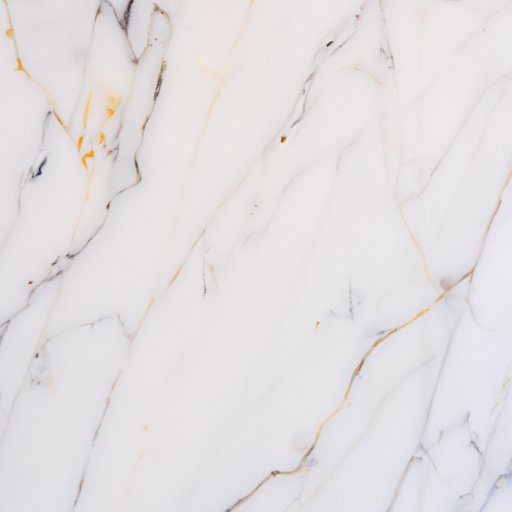Introduction
Cultured marble is an increasingly popular building material that is used in both residential and commercial settings. It has become a go-to choice for countertops, shower walls, bathroom fixtures, and other applications due to its durability, beauty, and affordability. But what is cultured marble made of? In this article, we will explore the composition of cultured marble, how it is manufactured, and the benefits and care associated with this versatile building material.

Exploring the Composition of Cultured Marble
Cultured marble is made from a blend of natural stone dust, polyester resin, pigments, and additives. The primary components of cultured marble are limestone dust, which is sourced from quarries, and polyester resin, which is a synthetic material. The combination of these two materials creates a durable, non-porous surface that is ideal for use in bathrooms, kitchens, and other wet areas.
The advantages of using cultured marble include its resistance to stains, scratches, and fading, as well as its ability to be easily cleaned and maintained. Additionally, the versatility of the material allows for a wide range of design options, from solid colors to intricate patterns and textures.
How Is Cultured Marble Manufactured?
The manufacturing process for cultured marble begins with the selection of raw materials, such as limestone dust, polyester resin, and pigments. The ingredients are then mixed together and poured into molds, which are usually made of fiberglass or steel. After the mixture is poured, it is left to cure and harden. Once the curing process is complete, the finished product is removed from the mold and polished to create a smooth, glossy finish.
To ensure quality control, manufacturers employ several measures. For instance, they may inspect the raw materials prior to mixing them together, as well as inspect the finished product before packaging and shipping. Additionally, they may also use specific testing methods to check for cracks and other imperfections in the finished product.

The Benefits of Cultured Marble
Cultured marble offers a number of advantages over other building materials. Firstly, it is extremely strong and durable, making it suitable for use in high-traffic areas. Secondly, it is non-porous, meaning it is resistant to water damage, staining, and bacteria growth. Finally, it is easy to clean and maintain.
Moreover, its versatility allows for a wide range of design possibilities. Solid colors can be used to create a classic look, while patterns and textures can provide a more modern aesthetic. Additionally, the material can be customized to fit any space, allowing for endless possibilities in terms of shape, size, and color.

Different Types of Cultured Marble
Cultured marble comes in a variety of styles and colors, allowing homeowners and designers to choose the perfect look for their space. Solid colors are available in a range of shades, including white, black, and gray. Additionally, patterns and textures can be added to give the material a unique look.
For those looking to make a bold statement, there are also specialty finishes available, such as metallic, glitter, and glass-like effects. These finishes can be used to create a luxurious look, adding a touch of glamour to any space.
Care and Maintenance of Cultured Marble
Cultured marble requires minimal maintenance to keep it looking its best. To clean the surface, only mild soap and warm water should be used. Additionally, the material should be sealed every two to three years to prevent staining and discoloration. If the surface is exposed to harsh chemicals or abrasive cleaners, it should be wiped down immediately to avoid damage.
In addition to regular cleaning and sealing, it is important to take preventive measures to protect the surface from water damage. For example, spills should be wiped up immediately, and it is recommended to use mats and runners in areas where water is present. If the material is exposed to standing water, it should be dried off immediately to prevent warping and discoloration.
Troubleshooting Common Issues with Cultured Marble
While cultured marble is a durable and long-lasting material, it is not immune to damage. Over time, the material may crack or discolor due to exposure to extreme temperatures or chemical cleaners. To minimize the risk of cracking, it is important to avoid placing heavy objects on the surface and to use protective mats and runners in areas prone to water damage.
In the event of water damage, it is important to act quickly to prevent further damage. First, the area should be dried off completely. Then, a sealant should be applied to protect the surface from future water damage. If the damage is extensive, it may be necessary to replace the affected area.
Conclusion
Cultured marble is a popular choice for bathrooms, kitchens, and other wet areas due to its durability, beauty, and affordability. The material is composed of limestone dust and polyester resin, and is manufactured using specific techniques and quality control measures. The material is also highly versatile, allowing for a range of design possibilities. With proper care and maintenance, cultured marble can last for many years.
(Note: Is this article not meeting your expectations? Do you have knowledge or insights to share? Unlock new opportunities and expand your reach by joining our authors team. Click Registration to join us and share your expertise with our readers.)
